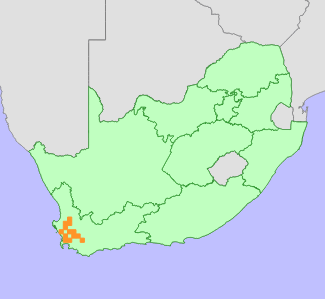|
Scientific Name | Ruschia diversifolia L.Bolus |
Higher Classification | Dicotyledons |
Family | AIZOACEAE |
Synonyms | Mesembryanthemum variifolium N.E.Br. |
National Status |
Status and Criteria | Vulnerable B1ab(i,ii,iii,iv,v) |
Assessment Date | 2016/01/14 |
Assessor(s) | L. von Staden & N.A. Helme |
Justification | EOO 8912 km², between eight and 10 severely fragmented remaining subpopulations continue to decline due to ongoing habitat loss and degradation. |
Distribution |
Endemism | South African endemic |
Provincial distribution | Western Cape |
Range | Piketberg to Tygerberg and Worcester. |
Habitat and Ecology |
Major system | Terrestrial |
Major habitats | Swartland Shale Renosterveld, Breede Shale Renosterveld, Swartland Granite Renosterveld, Breede Alluvium Renosterveld, Boland Granite Fynbos, Swartland Alluvium Fynbos, Breede Alluvium Fynbos |
Description | Lowland shale and alluvial renosterveld. |
Threats |
| This species has already lost more than 80% of its habitat to crop cultivation, and only small fragments remain. Habitat loss to further agricultural expansion continues in the Breede River Valley and the Swartland. Fragments on agricultural land that are not cultivated are often overstocked with livestock, causing ongoing degradation due to overgrazing, and most remaining fragments where this species was recently recorded are being overgrazed. Spreading, unmanaged alien invasive plants is also causing ongoing degradation at some locations. Around Paarl, Tygerberg and Worcester, habitat loss to urban expansion is an ongoing threat, with at least one subpopulation recently lost to development. |
Population |
The population of this formerly widespread species has been fragmented by extensive habitat loss. There are an estimated eight to ten remaining subpopulations, and more than half of these occur on small renosterveld remnants of only a few hectares. The population is therefore considered severely fragmented and continues to decline due to ongoing habitat loss and degradation.
|
Population trend | Decreasing |
Assessment History |
Taxon assessed |
Status and Criteria |
Citation/Red List version | | Ruschia diversifolia L.Bolus | VU B1ab(i,ii,iii,iv,v) | 2017.1 | | Ruschia diversifolia L.Bolus | Least Concern | Raimondo et al. (2009) | |
Bibliography |
Bolus, H.M.L. 1928-1935. Notes on Mesembrianthemum and allied genera. Part II. Bolus Herbarium, University of Cape Town, Cape Town.
Goldblatt, P. and Manning, J.C. 2000. Cape Plants: A conspectus of the Cape Flora of South Africa. Strelitzia 9. National Botanical Institute, Cape Town.
Manning, J.C. and Goldblatt, P. 2012. Plants of the Greater Cape Floristic Region 1: The Core Cape Flora. Strelitzia 29. South African National Biodiversity Institute, Pretoria.
Raimondo, D., von Staden, L., Foden, W., Victor, J.E., Helme, N.A., Turner, R.C., Kamundi, D.A. and Manyama, P.A. 2009. Red List of South African Plants. Strelitzia 25. South African National Biodiversity Institute, Pretoria.
|
Citation |
| von Staden, L. & Helme, N.A. 2016. Ruschia diversifolia L.Bolus. National Assessment: Red List of South African Plants version . Accessed on 2025/08/20 |
 Comment on this assessment
Comment on this assessment


